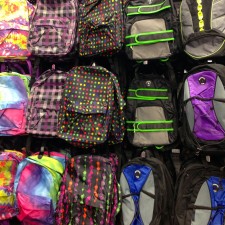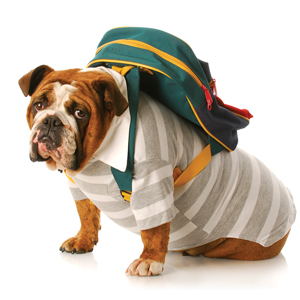 My children have specific criteria for their ideal backpacks. One insists on monkey graphics and the other a sports motif. If you and your child select a brand new backpack to begin the school year, chances are both of you have given a lot of consideration to personal preferences, such as color, characters, and brand. But what are the requisite features that help keep your kids safe from musculo-skeletal injuries? Whether you are sending your baby off to preschool for the first time or your firstborn away to college, equipping him with the right backpack and information on how to use it is important.
My children have specific criteria for their ideal backpacks. One insists on monkey graphics and the other a sports motif. If you and your child select a brand new backpack to begin the school year, chances are both of you have given a lot of consideration to personal preferences, such as color, characters, and brand. But what are the requisite features that help keep your kids safe from musculo-skeletal injuries? Whether you are sending your baby off to preschool for the first time or your firstborn away to college, equipping him with the right backpack and information on how to use it is important.
By now you may have heard about why it’s crucial for kids not to carry heavy backpacks. What other details do you need to know to keep your kids safe? And just how big a problem is this anyway? The American Occupational Therapy Association reports that more than 79 million students in the United States carry school backpacks. And, unfortunately, more than 23,000 backpack-related injuries were treated at hospital emergency rooms, doctor’s offices, and clinics in 2007. Good reason to ask a few questions in an effort to avoid a host of issues, including scoliosis, chronic pain, numbness and tingling in neck, arms, and hands, and even compromised lung function.
1. How heavy is too heavy?
The weight of the pack is probably no surprise. It’s not supposed to be heavy, right? But have you weighed it? Backpacks should not exceed 15 percent of a student’s body weight. About 55 percent of students carry a backpack that is heavier than the recommended guideline.
2. How can the weight be reduced?
Since packs seem to get heavier as the year progresses, encourage your child to regularly clean out unnecessary items. Try the once a week rule: If it hasn’t been used it in a week, it probably doesn’t need to be in the pack. Encourage children to use their lockers (if applicable) and to keep duplicate supplies at home and at school. Go digital if feasible to reduce the need for hard-cover books.
3. Is the pack well-designed?
This includes padding on shoulder straps at least two inches wide, as well as padding on the back of the bag. Multiple pockets also help to distribute the load more evenly, causing less stress.
4. Is it the right size?
The backpack should be no larger than the child’s back. The base of the pack should rest in the curve of the lower back and should never rest more than four inches below the child’s waist.
5. Is the pack being worn properly?
First and foremost, use both straps. If you attended high school and college in the late eighties and early nineties like I did, it was considered cool to wear your pack with only one strap. Although once a common occurrence, fortunately most students now wear both straps. Adjust the straps so that they fit snugly, but not too tight. Ensure the ends of the straps aren’t dangling, which might result in accidental tripping or entanglement. If you can talk your child into it, wearing the waist belt is recommended.
6. Is the load balanced?
Pack the heaviest items closest to your child’s back. When packing sharp items like pens and pencils, choose a lightweight case (mesh or plastic instead of metal) and ensure these items are contained so they don’t poke your child or shift around in the pack.
7. Are wheels really necessary?
Although it seems like a great idea to have a rolling backpack to get that weight off their shoulders, several things should be considered first: Is a rolling backpack even permitted at the school? Many schools do not allow them for various reasons. Will your child need to traverse bus steps or steps in the school building with the backpack? Backpacks with wheels are heavier than the standard backpack, so kids may be doing some unexpected awkward and heavy lifting. Is your child mature enough to handle a rolling bag? I have seen many a whirling dervish in the school halls, who simply hasn’t gotten the hang of where his body ends and the backpack begins, yielding potentially disastrous results. If you decide to go with a rolling pack, make sure the handle is long enough to avoid stooping when wheeling.
8. What’s the scoop on messenger bags?
Messenger bags may be trendy, and there are even some designs out there touted as Ergonomic. But keep in mind that these were built to give bike couriers easy access to their contents and are not appropriate for day-to-day loads. The American Academy of Pediatrics, among other groups, maintains that the safest way to carry a pack is by using two straps.
9. Is there a right way to lift?
Encourage your child to follow these steps to avoid injury from lifting: face the rear of the backpack; bend at your knees; use both hands; lift with the legs; slide on one shoulder strap around the back, then the other. As an alternative, back up to a suitable height table and put the pack on like a coat.
10. Whose backpack is it anyway?
Finally, encourage your children to take ownership of their backpacks. Not only will they feel good about themselves, but fostering independence at an early age is important. If you don’t believe me, just ask the parent I saw at the bus stop whose second grader flung her backpack in her mom’s direction and called out, “Here – carry this!”
In a study on the effect of backpack education on student behavior and health, nearly 8 out of 10 middle school students who changed how they loaded and wore their backpacks reported less pain and strain in their backs, necks, and shoulders. Following these steps will help reduce the chance of injury to your kids and get them on their way to good habits in carrying their school supplies for years to come.
For more information on backpack safety. Visit rfmonline.com and click on Tell me more.
Fiona Bessey-Bushnell is an occupational therapist, working in a local school system. She lives with her husband, and two children, 6 and 4, and happily reports they have been wearing their own backpacks since the age of two-and-a- half. You can read Fiona’s past Real Mom contributions at RFMonline.com.




